-
exotica
politics
klangkunst
spirits
science
words & voices
- Die Abwesenheit im Flug
- The Glory of the
Human Voice - Babylon
- Instructions
- La Notte
- Back from São Paulo
- Can america survive?
- Die Japan Nacht
- Back from Japan
- Quiet dogs in Cordoba
- Back from Bangkok
- Napoli
- Orient
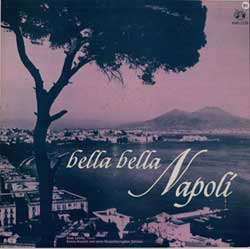
Diskutiert man mit Italienern über die Musik ihrer Heimat, wird irgendwann das Gespräch unweigerlich auf Neapel kommen. Egal ob traditionall oder Pop, hier scheint für viele die Wiege der italienischen Musik zu liegen. Zumindest, wenn es um Authentizität geht, um Lebendigkeit und Originalität. Welche interessanten Sänger hat schon Rom hervorgebracht (außer Gabriella Ferri), aber Neapel, Roberto Murolo, Nino Taranto, Salvadore di Giacomo usw.
Nicht zu vergessen den großen Totó, oder Roberto de Simone, den bedeutenden Komponisten, der die traditionelle Musik in die Moderne weiterführt, als Erbe großer Neapolitaner wie Alessandro Scarlatti (1660-1725, den Begründer der ‘Neapolitanischen Schule), Leoncavallo oder Pergolesi.
Heute also Tonträger mit traditioneller Musik der Fischer, über bekannte und meist weniger bekannte Canzone Napolitane, Musik der Marionettenspieler bis hin zu aktuellsten kritischen aber immer auch typisch neapolitanischen (Hiphop) Klängen.
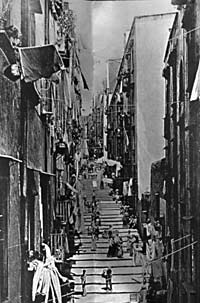
Turn your eyes upward, myriads of windows and balconies, curtains swinging in the sun, and leaves and flowers and among them, people, just to confirm your illusion. Cries, screams, whipcracks deafen you, the light blinds you, your brain begins to feel dizzy and you gulp air. You feel drawn into becoming part of the enthusiastic demonstration, to applaud, to cry “evvive” - but for what?
What is there before your eyes is nothing exceptional ... All is perfectly calm; no deep political passion is stirring in these people. They all mind their business and talk about normal things; it is just a day like any other. It is Naples’ life in its perfect normality, nothing more.
Renato Fucini, Naples through a naked eye, 1878
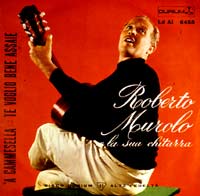 Roberto Murolo
Roberto Murolo
The son of poet Ernesto Murolo and Lia Cavalli, Roberto was born in Naples on 23 January 1912.
At an early age he had already attracted attention for his big passion for music, singing and the guitar. A passion that led him to form the Mida Quartet with which he toured all of Europe from 1939 to 1946.
On returning home in 1946, he began his inexorable career as a solo artist in the concert and recording fields. He also appeared in films such as Matarazzo's Catene (1950) with Amedeo Nazzari, and performed on the radio and the newly-introduced television.
After the many successes on various 78 r.p.m.'s, including A casciaforte and Scalinatella, Murolo recorded the famous Napoletana, an anthological collection of twelve records of Neapolitan songs from the 13th Century until modern times, put together between 1959 and 1963 with Edoardo Caliendo. In the mid-Seventies he broke off his recording activity, but not his concert career which saw him performing on stages all over the world until 1997. In 1990 he returned to recording again, with the album 'Na voce, 'na chitarra, which also includes songs by and with song-writers very dear to him, such as Spassionatamente by Paolo Conte, Lazzari felici by Pino Daniele, Senza fine by Gino Paoli, Caruso with Lucio Dalla at the piano, Ammore scombinato together with his friend Renzo Arbore, Sta musica with Consiglia Licciardi and L'ammore ca nun vene, two texts by Enzo Gragnaniello.
1992 saw the release of a new album called Ottantavoglia di cantare, celebrating his 80th birthday and marking a new milestone in his musical career. 2002 saw the release of his last CD: Ho sognato di cantare, the album announcing the end of his public commitment. Roberto Murolo died in his Naples home in March the following year.
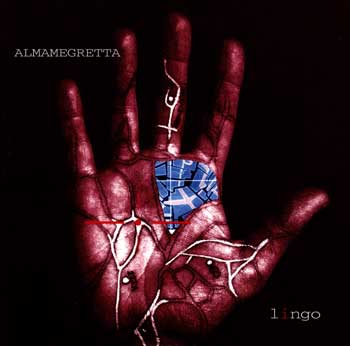
Dass es wie bei allen Nächten der verlorenen Musik nicht um Nostalgie geht, verdeutlichen bei unserer Napoli-Nacht exemplarisch drei hierzulande kaum bekannte Gruppen:
Almamegretta, 99 Posse & Napoli Centrale
Neues aus Neapel (CD Kritik zu Lingo)
Auch Italien ist ein multikulturelles Land. Was wir hierzulande als „italienische“ Kultur wahrnehmen, ist in Wahrheit ein Sammelsurium von „Mitbringseln“ und Traditionen ganz unterschiedlicher Herkunft. In Süditalien beispielsweise gab es jenseits von Kriegen und Eroberungen schon immer einen regen kulturellen Austausch mit den arabischen Völkern auf der anderen Seite des Mittelmeeres. Hier liegt eine der Wurzeln der neapolitanischen Band ALMAMEGRETTA (in etwa: Wandernde Seele); eine weitere liegt in Neapel selbst.
LINGO, die dritte CD der Band (1998), wird überwiegend im neapolitanischen Dialekt gesungen, der sich vom Italienischen immerhin genug unterscheidet, um dem Booklet eine italienische Übersetzung beilegen zu müssen. Die Sprache aber macht ALMAMEGRETTA noch lange nicht zu einer 'Ethno'-Band im typischen Sinne, denn die Drums&Beats-, Rap- und Hiphop-Einflüsse afro-amerikanischer Herkunft sind in ihren Stücken beherrschend. Ihr eindringlicher Sprechgesang klingt hart, die unterlegten Klänge arabischer Herkunft verwirren das MTV-gewöhnte Ohr.
ALMAMEGRETTA ist rau und kantig, selbst bei ruhigeren Titel wie FATMAH und RESPIRO, bleibt aber immer dancefloor-tauglich und sehr emotional. Insgesamt bildet LINGO eine abwechslungsreiche, rhythmische Symbiose zwischen verschiedenen Stilrichtungen und zeigt deshalb vielleicht Perspektiven für eine eigenständige, regional entwickelte aber global beeinflusste Definition des Begriffs 'Weltmusik'.
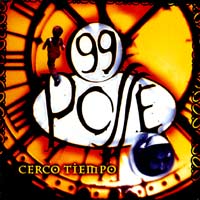 On May 1, 1991, the centro sociale Officina 99 was founded in Naples and became the incubator for the group 99 Posse that same year. The group's first singles "Rafaniello" and "Salario Garantito" was instrumental in bringing rap and raggamuffin to Italian musical scene.
On May 1, 1991, the centro sociale Officina 99 was founded in Naples and became the incubator for the group 99 Posse that same year. The group's first singles "Rafaniello" and "Salario Garantito" was instrumental in bringing rap and raggamuffin to Italian musical scene.
The following year, 99 Posse joined forces with Neapolitan bands Almamegretta and Bisca to record the single Sott'attacco dell'idiozi. It was from this close and dynamic colloboration that the super group Bisca99Posse came into being.
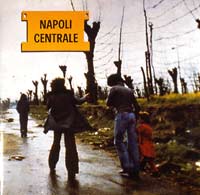 99 Posse's first full length album Curre Curre Guagliò was released in 1993 as a self-produced recording and, despite the fact that it was distributed underground, it went on to become a cultural manifesto with national ramifications. The album inspired Oscar award-winning director Gabriele Salvatores to make his film "Sud." BMG re-issued Curre Curre Guagliò in 1998.
99 Posse's first full length album Curre Curre Guagliò was released in 1993 as a self-produced recording and, despite the fact that it was distributed underground, it went on to become a cultural manifesto with national ramifications. The album inspired Oscar award-winning director Gabriele Salvatores to make his film "Sud." BMG re-issued Curre Curre Guagliò in 1998.
The group formed the record label, Novenove, that works to presents artists unable to make in the commercial music complex. The label released the compilation Cantanapoli Antifascista that brought together 10 of the most important Neapolitan groups in a musical assault on neofascism. All of 99 Posse's and Novenove's releases have been sold with a "prezzo politico" (political price). The sticker "Don't pay more than…" are promentantly displayed on the jewel cases.
For 99 Posse, this means "putting into practice a specific understanding about their relationship with the market, a sort of ideal practice." The 1996 album Cerco Tiempo sold over 70,000 copies. It contains a collaborative remake of dub master Linton Kweesi Johnson's "Making History" (Facendo la storia) plus a CD-ROM. The group's 1998 release Corto Circuito was recorded in four intense months between in Naples, Turin, and London.
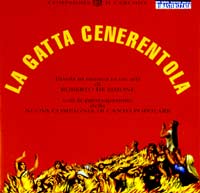 Roberto De Simone
Roberto De Simone
Für den Komponisten, Opernregisseur, Schriftsteller und Musikforscher Roberto De Simone ist Theater vor allem Imagination - und doch die einzige Möglichkeit, wahrhaftig zu kommunizieren. In seinen Kompositionen mischt er gekonnt die Volkskultur Neapels mit der großen Oper, spielt mit Versatzstücken der Musik- und Theatergeschichte, um sie neu zusammenzufügen. Musik, so meint er, ändert sich entlang des Fadens, der Zeit und Tradition verbindet.
Roberto de Simone, 1933 in Neapel geboren, begann seine Karriere zunächst als Pianist. Später arbeitete er als Regisseur, Schriftsteller, Komponist und Musikforscher. Von 1981 bis 1987 war er Künstlerischer Leiter des Theaters San Carlo und ist heute Direktor des Konservatoriums San Pietro a Majella in seiner Heimatstadt.
Sein Name verbindet sich vor allem mit der Nuova Compagnia di Canto Popolare, deren Mitbegründer und geistiger Kopf er war. Die Musikgruppe genoss in den 70er Jahren enorme Popularität und feierte auf der ganzen Welt Erfolge mit ihren Konzerten neapolitanischer und kampanischer Musik. Deren Traditionen hat De Simone intensiv studiert: Unter der Maske eines volkstümlichen Katholizismus verbergen sich magisch-matriarchalische Riten und Kulte. Ihre Ursprünge reichen in die Antike und den Orient zurück. Neapels Kunstmusik und volkstümliche orale Traditionen sind davon gleichermaßen beeinflusst.
Seit 1976 De Simones Volksoper La Gatta Cenerentola mit der Nuova Compagnia di Canto Popolare auf die Bühne gebracht wurde, gilt sein archaisches Aschenbrödel als meisterhafte Verbindung von Kunst- und Volksmusik, von Theater-Experiment und herkömmlichen Stilmitteln. ...Questi artisti, con semplicità, con amore e grande talento, ci facevano rivivere le nostre origini più remote, spesso intrecciate strettamente con le antichissime tradizioni di altri popoli mediterranei... (Eduardo De 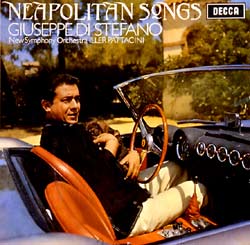 Filippo zur Nuova Compania)
Filippo zur Nuova Compania)
Infos zur „Nuova Compagnia di Canto Popolare“: digilander.libero.it/nuovacompagnia/s.htm
Cover of the week Aus der Serie Sänger mit Hund in Cabrio: Giuseppe Di Stefano.
Neapolitan Songs. Decca, 1960er,
New Symphony Orchestra Iller Pattacini
zum Thema Italia siehe auch
La Notte
La Linea
Bande Musicali di Sicilia
Parole italiane